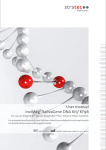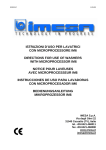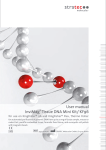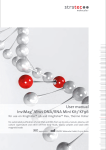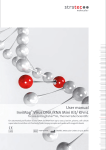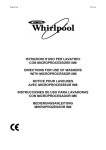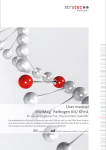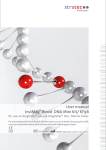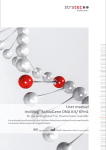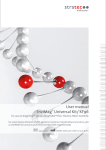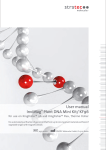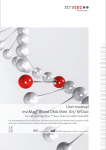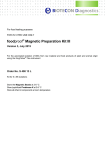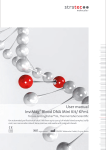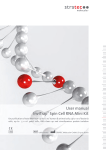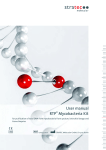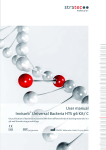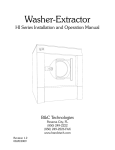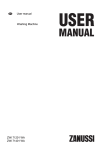Download InviMag Universal Bacteria Kit/ KF96
Transcript
User manual InviMag® Universal Bacteria Kit/ KF96 for use on KingFisher® 96 and KingFisher® Flex, Thermo Fisher for automated purification of bacterial DNA from different types of specimen: swabs, tissue, food, paraffin embedded tissue, urine, blood or water samples with magnetic beads REF 7433300x00 STRATEC Molecular GmbH, D-13125 Berlin Instruction for InviMag® Universal Bacteria Kit /KF96 The InviMag® Universal Bacteria Kit/ KF96 is the ideal tool for isolation and purification of bacterial DNA with enhanced performance and reproducibility from different clinical specimen like whole blood, swabs, biopsy material and from cell-free body fluids like urine, serum, plasma and synovial fluids in a convenient 96 well format using the innovative STRATEC Molecular technology in combination with Thermo Fisher instruments. The use of KingFisher instruments allow time-saving processing of large sample numbers without any cross-contaminations. Furthermore, the user is flexible in the choice of the starting amount material. The kit composition of the InviMag® Universal Bacteria Kit/ KF96 is designed for the use on KF96 or KFflex96 instruments. The kit is neither validated for the isolation of human or bacterial genomic DNA from fecal samples nor for viral nucleic acids or total RNA isolation. Trademarks: InviMag®, Invisorb®. Registered marks, trademarks, etc. used in this document, even when not specifically marked as such, are not to be considered unprotected by law. The Invisorb® technology is covered by patents and patent applications: US 6,110363, US 6,043,354, US 6,037,465, EP 0880535, WO 9728171, WO 9534569, EP 0765335, DE 19506887, DE 10041825.2, WO 0034463. InviMag® and Invisorb® are registered trademarks of STRATEC Biomedical AG. The PCR process is covered by US Patents 4,683,195, and 4,683,202 and foreign equivalents owned by Hoffmann-La Roche AG. © 2015 STRATEC Molecular, all rights reserved. ® InviMag Universal Bacteria Kit /KF96 0515 Table of Content Kit contents of InviMag® Universal Bacteria Kit/ KF96 3 ® Kit contents of InviMag Universal Bacteria Kit/ KF96 w/o plastic 4 Symbols 5 Storage Quality control 5 5 Intended use 6 Product use limitation 6 Safety information Product characteristic of the InviMag Universal Bacteria Kit /KF96 7 8 Yield and quality of bacterial DNA 8 Protocol validation Principle and procedure 9 11 Sampling and storage of starting material 11 Procedure 12 Important notes Important indications 13 13 Preparing reagents and buffers 13 Preparing buffers 14 Reagents and equipment to be supplied by user Scheme of InviMag® Universal Bacteria Kit /KF96 14 15 Sample preparation 16 Starting a run - Protocol for isolation of bacterial DNA from clinical samples, ‘ bacteria culture, swab or urine 17 Starting a run - Protocol for isolation of bacterial DNA from food or tissue samples 19 Protocol 1: Purification of bacterial DNA from clinical samples (serum, plasma, blood and cell-free body fluid sample) 21 Protocol 2: Purification of bacterial DNA from bacterial cultures 21 Protocol 3: Purification of bacterial DNA from food samples 21 Protocol 4: Purification of bacterial DNA from swab 22 Protocol 5: Purification of bacterial DNA from urine 22 Protocol 6: Purification of bacterial DNA from small tissue samples 22 For self-programming of the KF96 and KFflex96 instrument For self-programming of the KF96 and KFflex96 instrument (Cell protocol) 23 27 Troubleshooting 31 Appendix 32 General notes on handling DNA 33 Ordering information 34 ® ® InviMag Universal Bacteria Kit /KF96 0515 Kit contents of InviMag® Universal Bacteria Kit/ KF96 Store the MAP Solution A at 4°C! Store dissolved Proteinase K at -20°C! Store all other kit components at room temperature (RT)! 1 x 96 extractions 5 x 96 extractions 7433300100 7433300200 15 ml 50 ml 150 mg 500 mg 30 ml 110 ml 2 x 1.1 ml working solution 10 ml working solution 8 ml final volume 32 ml 30 ml final volume 120 ml 2 x 1.1 ml 10.5 ml Wash Buffer I 80 ml final volume 160 ml 2 x 125 ml final volume 2 x 250 ml Wash Buffer II 60 ml final volume 200 ml 4 x 60 ml final volume 4 x 200 ml Elution Buffer 30 ml 110 ml 2.0 ml Deep Well Plate 5 5x5 KF96 Tip Comb for DW magnets 1 5 200 µl Elution Plate 2 2x5 2 x 50 10 x 50 Sealing Foils 2 10 Manual 1 1 Add 24 ml of 99.7% isopropanol to the Binding Buffer HL. Mix by intensive shaking. Always mix shortly before use. Add 90 ml of 99.7% isopropanol to the Binding Buffer HL. Mix by intensive shaking. Always mix shortly before use. Dilute each Proteinase K tube by addition of 1.1 ml ddH2O, mix thoroughly until completely dissolving and store at -20°C! Dilute Proteinase K by addition of 10 ml of ddH2O, mix thoroughly until completely dissolving and store at 20°C! Dilute all Lysozyme directly before use with all of the provided Lysozyme Buffer. Store diluted Lysozyme at -20°C Dilute all Lysozyme directly before use with all of the provided Lysozyme Buffer. Store diluted Lysozyme at -20°C. Add 80 ml of 96-100% ethanol to the bottle Wash Buffer I, mix thoroughly and always keep the bottle firmly closed Add 125 ml of 96-100% ethanol to each bottle Wash Buffer I, mix thoroughly and always keep the bottle firmly closed Add 140 ml of 96-100 % ethanol to the bottle Wash Buffer II, mix thoroughly and always keep the bottles firmly closed Add 140 ml of 96-100% ethanol to the bottle Wash Buffer II, mix thoroughly and always keep the bottles firmly closed Catalogue No. Lysozyme Buffer Lysozyme Lysis Buffer HL Proteinase K Binding Buffer HL MAP Solution A 1.5 ml Receiver Tubes Initial steps ® InviMag Universal Bacteria Kit /KF96 0515 Kit contents of InviMag® Universal Bacteria Kit /KF96 w/o plastic Store the MAP Solution A at 4°C! Store dissolved Proteinase K at –20°C! Store all other kit components at room temperature (RT)! 1 x 96 extractions 5 x 96 extractions 7433300150 7433300250 15 ml 50 ml 150 mg 500 mg 30 ml 110 ml 2 x 1.1 ml working solution 10 ml 8 ml final volume 32 ml 30 ml final volume 120 ml 2 x 1.1 ml 10.5 ml Wash Buffer I 80 ml final volume 160 ml 2 x 125 ml final volume 2 x 250 ml Wash Buffer II 60 ml final volume 200 ml 4 x 60 ml final volume 4 x 200 ml Elution Buffer 30 ml 110 ml 1.5 ml Receiver Tubes 2 x 50 10 x 50 Sealing Foils 2 10 Manual 1 1 Add 24 ml of 99.7% isopropanol to the Binding Buffer HL. Mix by intensive shaking. Always mix shortly before use. Add 90 ml of 99.7% isopropanol to the Binding Buffer HL. Mix by intensive shaking. Always mix shortly before use. Dilute each Proteinase K tube by addition of 1.1 ml ddH2O, mix thoroughly until completely dissolving and store at -20°C! Dilute Proteinase K by addition of 10 ml of ddH2O, mix thoroughly until completely dissolving and store at 20°C! Catalogue No. Lysozyme Buffer Lysozyme Lysis Buffer HL Proteinase K Binding Buffer HL MAP Solution A Initial steps Dilute Lysozyme directly before Dilute Lysozyme directly before use use with the provided Lysozyme with the provided Lysozyme Buffer. Buffer. Store diluted Lysozyme at Store diluted Lysozyme at -20°C. -20°C Add 125 ml of 96-100% ethanol to Add 80 ml of 96-100% ethanol to each bottle Wash Buffer I, mix the bottle Wash Buffer I, mix thoroughly and always keep the bottle thoroughly and always keep the firmly closed bottle firmly closed Add 140 ml of 96-100% ethanol to the Add 140 ml of 96-100 % ethanol to bottle Wash Buffer II, mix thoroughly the bottle Wash Buffer II, mix and always keep the bottles firmly thoroughly and always keep the closed bottles firmly closed Plastic to be supplied by user (see order information) 2.0 ml Deep Well Plate 5 25 KF96 Tip Comb for DW magnets 1 5 200 µl Elution Plate KF96 2 10 ® InviMag Universal Bacteria Kit /KF96 0515 Symbols Manufacturer Lot number Catalogue number Expiry date Consult operating instructions Temperature limitation Do not reuse Storage All buffers and kit contents of the InviMag® Universal Bacteria Kit/ KF96, except MAP Solution A, are stable for at least 12 months. MAP Solution A is stable for at least 6 months. All buffers and kit contents of the InviMag® Universal Bacteria Kit/ KF96, except Lysozyme, dissolved Proteinase K and MAP Solution A, should be stored at room temperature. Proteinase K: Dissolved Proteinase K should be stored in aliquots at –20°C. Avoid multiple freezing and thawing cycles. Lysozyme: Lyophilized Lysozyme should be stored at 4-8°C. Dissolved Lysozyme should be stored in aliquots at –20°C. Avoid multiple freezing and thawing cycles. MAP Solution A: The beads must be stored at 2-8°C. Wash Buffers: Wash Buffers charged with either ethanol or isopropanol should be stored at room temperature and must be appropriately sealed. If any precipitates within the provided solutions are visible, redissolve them by carefully warming up to 30°C. Room temperature is defined as range from 15–30°C. Quality control and product warranty STRATEC Molecular warrants the correct function of the InviMag® Universal Bacteria Kit/ KF96 for applications as described in the manual. Purchasers must determine the suitability of the product for its particular use. Should any product fail to perform in applications as described in the manual, STRATEC Molecular will check the lot and if a problem in the lot is detected, STRATEC Molecular will replace the product free of charge. STRATEC Molecular reserves the right to change, alter, or modify any product to enhance its performance and design at any time. In accordance with STRATEC Molecular’s ISO 9001-2000 and ISO EN 13485 certified Quality Management System the performance of all components of the InviMag® Universal Bacteria Kit/ KF96 have been tested separately against predetermined specifications routinely on lot-to-lot to ensure consistent product quality. If any questions or problems arise regarding any aspects of InviMag® Universal Bacteria Kit/ KF96 or other STRATEC Molecular products, please do not hesitate to contact us. A copy of STRATEC Molecular’s terms and conditions can be obtained upon request or are presented at the STRATEC Molecular webpage. ® InviMag Universal Bacteria Kit /KF96 0515 For technical support or further information please contact: from Germany +49-(0)30-9489-2901/ 2910 from abroad +49-(0)30-9489-2907 or contact your local distributor Intended use The InviMag® Universal Bacteria Kit /KF96 allows rapid and economic isolation of high quality bacterial DNA from up to 100 µl of fresh or frozen blood, plasma, serum, cell-free body fluids of human origin like urine, as well as rinsed liquid from swabs or cell pellets in a convenient 96 well format using the InviMag® technology and the KF96 or KFflex96 instrument from Thermo Scientific. Fresh or frozen blood, plasma or serum from common blood collection systems can be used, stabilized with EDTA or citrate, but not with heparin. The extracted high quality bacterial DNA is suitable for a wide variety of downstream applications. For reproducible and high yields, appropriate sample storage is essential. Yields may vary from sample to sample depending on factors such as the health of the donor, patient medication or sample storage conditions. The purified DNA is of high quality and free of proteins, nucleases and/or other impurities and is ready-to-use for different downstream applications like PCR, quantitative PCR, real-time PCR or other routine downstream methods. THE PRODUCT IS INDENTED FOR USE BY PROFESSIONALS ONLY, SUCH AS TECHNICIANS, PHYSICIANS AND BIOLOGISTS TRAINED IN MOLECULAR BIOLOGICAL TECHNIQUES. The kit is designed to be used with any downstream application employing enzymatic amplification or other enzymatic modifications of DNA followed by signal detection or amplification. Any diagnostic results generated by using the sample preparation procedure in conjunction with any downstream diagnostic assay should be interpreted with regard to other clinical or laboratory findings. To minimize irregularities in diagnostic results, adequate controls for downstream applications should be used. Product use limitation The kit is neither validated for the isolation of human or bacterial genomic DNA from fecal samples nor for viral nucleic acids or any kind of RNA isolation. The included chemicals are only useable once. Differing the starting material or flow trace may lead to inoperability. Therefore, neither a warranty nor guarantee will be given, implied or expressed if the respective protocol is changed. The user is responsible to validate the performance of the STRATEC Molecular product for any particular use. STRATEC Molecular does not provide validations of performance characteristics of the product with respect to specific applications. STRATEC Molecular products may be used, e.g. in clinical diagnostic laboratory systems conditioned upon the complete diagnostic system of the laboratory, after the laboratory has been validated pursuant to CLIA’ 88 regulations in the U.S. or equivalents in other countries. All products sold by STRATEC Molecular are subject to extensive quality control procedures (according to ISO 9001-2000 and ISO EN 13485) and are warranted to perform as described herein. Any problems, incidents or defects shall be reported to STRATEC Molecular immediately upon detection thereof. The chemicals and the plastics are for laboratory use only. They must be stored in the laboratory and must not be used for other purposes than intended. The product with its contents is not suitable for consumption. ® InviMag Universal Bacteria Kit /KF96 0515 Safety information When and while working with chemicals, always wear a suitable lab coat, disposable gloves, and protective goggles! Avoid direct skin contact! Adhere to the legal requirements for working with biological material! For more information, please consult the appropriate material safety data sheets (MSDS). These are available online in convenient and compact PDF format at www.stratec.com for each STRATEC Molecular product and its components. If buffer bottles are damaged or leaking, WEAR GLOVES, AND PROTECTIVE GOGGLES when discarding the bottles in order to avoid any injuries. STRATEC Molecular has not tested the liquid waste generated by the InviMag® Universal Bacteria Kit /KF96 procedures for residual risk materials. Therefore, all liquid waste should be handled and discarded accordingly to local safety regulation. European Community risk and safety phrases for the components of the InviMag® Universal Bacteria Kit /KF96 to which they apply, are listed below as follows: Lysis Buffer HL: Proteinase K warning H302-315-319 P280-305-351-338 danger H315-319-334-335 P280-305-351-338-310-405 Wash Buffer I warning H302-312-332-412 EUH032 P273 H302: H315: H319: H334: H335: H312: H332: H412: EUH032: P280: P305+P351+P338: P310: P405: P273: Harmful if swallowed. Causes skin irritation. Causes serious eye irritation. May cause allergy or asthma symptoms or breathing difficulties if inhaled. May cause respiratory irritation. Harmful in contact with skin. Harmful if inhaled. Harmful to aquatic life with long lasting effects. Contact with acids liberates very toxic gas. Wear protective gloves/protective clothing/eye protection/face protection. If in eyes: Rinse cautiously with water for several minutes. If present, remove contact lenses and continue rinsing. Immediately call a POISON CENTER or doctor/physician. Store locked up. Avoid release to the environment. Emergency medical information can be obtained 24 hours a day from infotrac: outside of USA: inside of USA: 1 – 352 – 323 – 3500 1 – 800 – 535 – 5053 7 ® InviMag Universal Bacteria Kit /KF96 0515 Product characteristic of the InviMag® Universal Bacteria Kit /KF96 Starting material 9 up to 10 bacteria, 1-10 mg tissue, biopsy, paraffin embedded tissue, 1-100 µl whole blood, 200 µl cell-free body fluid, 15-50 ml urine, paper points, swabs, up to 1 l water Yield Time depends on the starting material approx. 70 minutes (including lysis) The InviMag® Universal Bacteria Kit /KF96 is designed for a semi-automated preparation of bacterial DNA form different clinical sample materials in a 96 well format using magnetic beads and the KF96 or KFflex96 instrument from Thermo Scientific. The isolation process is based on the patented InviMag® technology which is used for isolation of DNA by binding of the nucleic acids onto magnetic particles. In the first step, all samples are adjusted to a final sample volume of 100 µl using 1x PBS or distilled water before the 96 well format is applied. The samples are pretreated with Lysozyme at 37°C to break the bacterial cell wall in presence of lysis buffer. Proteins are degraded during lysis upon addition of Proteinase K in a step performed at 56°C on the instrument. The lysis efficiency is improved by mixing the samples during the lysis step controlled by the magnetic rods of the King Fisher instrument. After addition of magnetic beads and binding buffer, to adjust optimal binding conditions, the DNA, bound to the magnetic beads, are transported through several washing steps and a final elution step. The procedure requires only minimal interaction by the user, allowing safe handling of potentially infectious samples. The procedure is designed to avoid sample-tosample cross-contaminations. The bacterial DNA extraction protocols described herein are designed for walk-away automated preparation of bacterial DNA using different materials in combination with the InviMag® technology. The extracted bacterial DNA is of very high quality and suitable for a wide variety of downstream applications or can be stored at -20°C for subsequent use. The isolation protocols and all required buffers are optimized to provide highest yields and purities of the extracted bacterial DNAs. ○ ○ ○ ○ PCR * Real-time PCR RFLP analysis Restriction enzyme digestion Yield and quality of bacterial DNA The amount of isolated, purified DNA depends on the type of sample, bacterial titer, sample source, transport, storage and age. Eluates derived by this kit will contain Carrier-RNA, which will greatly exceed the amount of the isolated NA. Yields of bacterial nucleic acids isolated from biological samples are usually low concentrated and therefore almost impossible to determine photometrically.* * Keep in mind that the Carrier-RNA (5 μg per 200 μl sample) will account for most of the present RNA. ** The PCR process is covered by US Patents 4,683,195, and 4,683,202 and foreign equivalents owned by Hoffmann-La Roche AG. 8 ® InviMag Universal Bacteria Kit /KF96 0515 Yield and quality of isolated bacterial DNA is suitable for any molecular-diagnostic detection system. The diagnostic tests should be performed accordingly to the manufacturer´s specifications. Protocol validation Verification Testing The bacterial DNA extraction protocol was intensively tested on a KFflex96 instrument with the provided reagents and consumables. Typical results for the extraction of bacterial DNA from buffer, plasma and blood are shown below. Actual results can vary, depending upon sample age, quality, type, bacterial titer and host. Samples For testing, frozen cell pellets from the Gram-positive bacterium Bacillus subtilis were used in different dilutions in combination with different matrices. The cells were grown in an overnight culture and the derived cell pellets from 1 ml of this culture were stored at -20°C until further use. In all experiments, a fresh pellet was used from the -20°C stock. At all times, thawed and unused cells were discarded after the experiment. The detection was done by an in-house Bacillus subtilis real-time PCR based detection assay. All real-time PCRs were performed on a Corbett Rotor-Gene 3000. PCR Inhibitor and Cross Contamination Test To maximize the detection of any potential contamination event, positive and no sample controls were arranged in alternating wells (in a “checkerboard” pattern Fig. 1) using the InviMag® Universal Bacteria Kit /KF96. Out of those samples, Fig. 2 shows a real-time PCR run of the extracted DNAs. The PCR was done with an in-house SYBR Green based real–time PCR assay on a Corbett Rotor-Gene 3000 machine. 1 2 3 4 5 6 7 8 9 10 11 12 A B C D E F G H Fig. 1 ‘Checkerboard Pattern: Utilized for the cross-contamination analysis test. Samples (red) and no sample controls (white) arranged in alternating wells. 9 ® InviMag Universal Bacteria Kit /KF96 0515 Fig. 2: Real-time PCR results (left figure) from positive samples (host: Bacillus subtilis; dark blue) and no sample controls (water; cyan) arranged in a Checkerboard pattern. NTC (no template control; black) and PTC (positive template control; red) are shown also. The right figure shows the corresponding melting curves. Color Name Ct Rep. Ct Rep. Ct Std. Dev. Sample 16.19 16.38 2.75 No sample 26.54 27.38 0.54 PTC 16.69 16.65 0.05 NTC 23.82 25.27 2.06 Tab. 1 The table shows the high reproducibility of the mean Ct value and the standard deviation. Reproducibility To demonstrate the reproducibility of the InviMag® Universal Bacteria Kit /KF96 bacterial DNA extractions were performed in dilution series. Typical results are shown below: Fig. 3 On the left side real-time PCR results of an extracted DNA from a dilution series of B. subtilis in TE buffer is shown. On the right side the corresponding melting curves for the resulting PCR products are shown. 10 ® InviMag Universal Bacteria Kit /KF96 0515 Color Name mean Ct mean Ct Std. Dev. 10e-3 18.90 0.09 10e-4 22.45 0.16 10e-5 26.04 0.27 10e-6 30.91 1.03 PTC 14.36 0.08 Tab. 2 Ct values and standard deviations for the real-time PCR are shown above in figure 3. Colors belong to the curves in figure 3. Principle and procedure The InviMag® Universal Bacteria Kit /KF96 procedure comprises the following steps: ○ ○ ○ ○ ○ sample pre-treatment and normalization of all samples lysis of bacterial cells binding of bacterial DNA to magnetic beads washing and elimination of ethanol elution of total DNA (bacterial, mitochondrial) The samples are lysed in optimized buffers and enzyme mixtures. The lysates are transferred to the subsequent automatic purification procedure based on magnetic beads. The DNA binds to the magnetic particles, is purified by several washing steps and then finally eluted. The purified, high quality DNA is ready-to-use for subsequent downstream applications, e.g. for PCR amplification, quantitative PCR, real-time PCR or other routine downstream methods. This manual contains 6 protocols. Sampling and storage of starting material Bacterial cultures Bacterial cultures should be grown in presence of a selective agent such as an antibiotic. The yield and quality of DNA may depend on factors such as host strain, inoculation, antibiotic, and type of culture medium. The bacteria are centrifuged after cultivation. Best results are obtained with fresh or deep-frozen (-20°C or -80°C) material. Repeated freezing and thawing cycles of stored samples should be avoided because this may lead to degraded DNA. Paper points Paper points can be stored at room temperature for up to 6 hours. For long-term storage, we recommend a dry storage at 2-8°C. Blood Blood samples can be stored at room temperature for up to 6 hours or at 2-8°C for up to 24 hours. For long-term storage, we recommend freezing and storing samples at -20°C or -80°C. Multiple thawing and freezing cycles before isolating the DNA should be avoided. If cryoprecipitates (formed during thawing of frozen samples) are visible, avoid aspirating them. The amount of purified DNA from up to 100 µl whole blood depends on the white blood cell content. Different primary tubes and anticoagulants (except heparin) can be used to collect blood samples. 11 ® InviMag Universal Bacteria Kit /KF96 0515 Tissue/ biopsy material Best results are obtained with fresh material or material that has been immediately frozen and stored at -20°C or -80°C. Repeated freezing and thawing cycles of stored samples should be avoided because this may lead to degraded DNA. Use of poor quality starting material also leads to reduced yields. The amount of purified DNA from up to 10 mg tissue sample depends on the nature of starting material. Urine The bacteria must be centrifuged and the supernatant is completely removed (urea contaminations can inhibit PCR reactions). Best results are obtained with fresh or deepfrozen bacterial pellets. Repeated freezing and thawing cycles of stored samples should be avoided because this may lead to degraded DNA. The amount of purified DNA from up to 1550 ml urine depends on the bacterial titer. Swabs, saliva The protocol works with fresh saliva, prepared swabs as well as with dried swabs. Please note that stored and dried swab samples are often characterized by isolation of apoptotic DNA (visible on agarose gel as a typical apoptotic DNA pattern).The protocol has not been validated for isolation of DNA from swabs which are stored in special storage buffers from other providers. Pathogens (Listeria ssp.) in food material For the detection of bacteria (Listeria) in foods an enrichment and cultivation, following the EU regulations and §35 of the food law, has to be done. An aliquot of the prepared culture is used and the bacteria are centrifuged after cultivation. Best results are obtained with fresh material or material that has been immediately frozen and stored at -20°C or -80°C. Repeated freezing and thawing cycles of stored samples should be avoided because this may lead to degraded DNA. STRATEC Molecular will be released of its responsibilities if other sample materials than described in the Intended Use are processed or if the sample preparation protocols are changed or modified. Procedure Normalization Each sample is mixed with 1x PBS or dd-H2O and filled up to a final volume of 100 μl. Sample preparation Bacteria must be cultivated at special conditions. An aliquot of the suspension is used to form a bacterial pellet by centrifugation at high speed for 5 min while the supernatant is removed. Lysis Lysis is performed in two steps. First the cell wall of the bacteria is destroyed in the presence of Lysozyme. Then the samples are lysed at denaturing conditions and elevated temperatures while continuously shacking using Lysis Buffer HL and Proteinase K. DNases are inactivated whereas the bacterial DNA is secured. Binding genomic DNA Upon adding Binding Buffer HL and MAP Solution A to the lysate, optimal binding conditions are adjusted. The DNA is bound to the magnetic beads which will be mixed and transported by the magnetic rods. Removing residual contaminants Contaminants are efficiently removed using different Wash Buffers while the bacterial DNA remains bound to the beads. 12 ® InviMag Universal Bacteria Kit /KF96 0515 Elution of pure genomic DNA The bacterial DNA is finally eluted from the beads using Elution Buffer. The eluted DNA is ready-to-use in different downstream applications. Important notes Important points before starting a protocol Immediately upon receipt of the product, inspect the kit and its components as well as the package for any apparent visible damages and correct quantities. If there are any unconformities, notify STRATEC Molecular immediately in writing with immediate effect upon inspection thereof. If buffer bottles are damaged, contact the STRATEC Molecular Technical Services or your local distributor. In case of liquid spillage, refer to “Safety Information” (see page 7). Do not use damaged kit components, because their use may lead to poor kit performance. ○ ○ ○ ○ ○ ○ ○ ○ Always change pipet tips between different liquid transfers. To avoid crosscontaminations, we recommend the use of aerosol-barrier pipet tips. All centrifugation steps are carried out at room temperature. When working with chemicals, always wear a suitable lab coat, disposable gloves and protective goggles. Discard contaminated gloves immediately. Only combine components of different kits if the lot numbers are identical. Avoid microbial contaminations of the kit reagents. To minimize the risk of infections from potentially infectious material, we recommend preparing the samples using a laminar air-flow box. The kit should only be used by trained personnel. Important indications ○ ○ ○ ○ ○ Optimal disruption of tissue is important for obtaining maximum yields and purities. For high sample throughput it is recommended to use a mixer mill or a similar device for disruption. It is recommended to centrifuge the isolated DNA for 1 min at maximum speed before starting any application. It is recommended to use multi-channel pipettes, esp. electric multi-channel pipettes with a capacity of 1 ml. Bacteria must be cultivated at special conditions. An aliquot of the bacterial suspension is used to obtain a pellet by centrifugation at high speed for 5 min. The supernatant is discarded. See sample preparation (page 12) Preparing reagents and buffers Prior to each run Before starting a run, equilibrate all reagents at room temperature. Where necessary, gently mix and redissolve any precipitates by warming up to 30°C. Swirl gently to avoid foaming. Lysis Buffer HL and Elution Buffer: are ready-to-use. Lysozyme: Lysozyme should be prepared directly before starting a run. Solve the lyophilized powder by adding Lysozyme Buffer. Mix thoroughly until the entire enzyme is solved. For long-time storage we recommend to prepare aliquots and store them at -20°C. Avoid repeated freezing and thawing cycles. 13 ® InviMag Universal Bacteria Kit /KF96 0515 Proteinase K: Add the described amount of ddH2O (see table below) to the tube or bottle containing the Proteinase K, mix thoroughly and store unused Proteinase K at -20°C. Dividing the solved Proteinase K into aliquots for long-term storage is recommended. Avoid repeated freezing and thawing cycles. Wash Buffers: Before first use, add the described volume of 96-100% ethanol to the bottles labeled with Wash Buffer I and Wash Buffer II as described in the Kit content (page 2) or see below. After addition of ethanol mix shortly and keep unused bottles firmly closed! Binding Buffer: Add the described volume of isopropanol to the bottle labeled with Binding Buffer HL as described in the Kit content (page 2) or see below. After addition of isopropanol mix shortly and keep unused bottles firmly closed! Preparing buffers 1x 96 bacterial DNA-extractions Add 24 ml of 99.7% Isopropanol to the Binding Buffer HL. Mix by intensive shaking for 1 min. Mix thoroughly before each use. Dilute each Proteinase K tube by addition of 1.1 ml of ddH2O, mix thoroughly until completely dissolving and store at -20°C! Dilute all Lysozyme directly before use with all of the provided Lysozyme Buffer. Store diluted Lysozyme at -20°C Add 80 ml of 96-100% ethanol to the bottle Wash Buffer I, mix thoroughly and always keep the bottle firmly closed Add 140 ml of 96-100% ethanol to the bottle Wash Buffer II, mix thoroughly and always keep the bottle firmly closed 5x 96 bacterial DNA-extractions Add 90 ml of 99.7% Isopropanol to the Binding Buffer HL. Mix by intensive shaking by inverting for 1 min. Mix thoroughly before use Dilute Proteinase K by addition of 10 ml of ddH2O, mix thoroughly until completely dissolving and store at 20°C! Dilute all Lysozyme directly before use with all of the provided Lysozyme Buffer. Store diluted Lysozyme at -20°C Add 125 ml of 96-100% ethanol to each bottle Wash Buffer I, mix thoroughly and always keep the bottle firmly closed Add 140 ml of 96-100% ethanol to the bottle Wash Buffer II, mix thoroughly and always keep the bottles firmly closed Reagents and equipment to be supplied by user ○ ○ ○ ○ ○ ○ Measuring cylinder (250 ml) Pipette and pipette tips Disposable gloves Vortexer 96-100% ethanol Isopropanol* *The InviMag® Universal Bacteria Kit /KF96 is validated with 2-Propanol; Rotipuran >99.7%, p.a., ACS, ISO (Order no. 6752) from Carl Roth * Possible suppliers for Isopropanol: Carl Roth 2-Propanol Rotipuran >99.7%, p.a., ACS, ISO Order no. 6752 Sigma 2-Propanol Order no. 59304-1L-F Applichem 2-Propanol für die Molekularbiologie Order no. A3928 14 ® InviMag Universal Bacteria Kit /KF96 0515 Scheme of the InviMag® Universal Bacteria Kit /KF96 Each sample with a volume smaller than 100 µl must be adjusted with dd H2O or 1x PBS to a final volume of 100 µ. During lysis, prefill all Deep Well Plates with the required buffers and appropriate volumes as shown below: Tip Plate: Insert the KF96 Tip Comb for DW magnets on a Tip Plate* Binding Plate: Add to 470 µl lysed sample (total), 250 µl Binding Buffer HL and 20 µl MAP Solution A into a 2 ml Deep Well Plate Washing Plate 1: Add 500 µl Wash Buffer I into a 2 ml Deep Well Plate Washing Plate 2: Add 500 µl Wash Buffer I into a 2 ml Deep Well Plate Washing Plate 3: Add 800 µl Wash Buffer II into a 2 ml Deep Well Plate Washing Plate 4: Add 800 µl Wash Buffer II into a 2 ml Deep Well Plate Elution Plate: Add 200 µl Elution Buffer into the KF Elution Plate (same size as Tip Plate) Attention: Tissue and food samples require a modified protocol! The prepared starting material is lysed in presence of Proteinase K, Lysozyme and Lysis Buffer HL After lysis, a pause occurs and Binding Buffer HL (follow preparing instructions) and MAP Solution A (magnetic beads) are added to each sample containing cavity DNA binds to magnetic beads Magnetic separation Four washing steps of the particle fixed DNA using Wash Buffer I and Wash Buffer II Magnetic separation & evaporation of ethanol Elution of DNA using Elution Buffer Bead removal Pure DNA * Elution Plates and Tip Plates are identically. Use one provided Elution Plate as a Tip Plate. 15 ® InviMag Universal Bacteria Kit /KF96 0515 Sample preparation Bacteria must be cultivated at special conditions. An aliquot of the suspension will be used to form a bacterial pellet by centrifugation at high speed for 5 min while the supernatant is discarded. General considerations A summary of sample setup is described in the table below: Sample and sample size Condition 10-100 µl blood Fresh / frozen with anticoagulants Adjust to 100 µl with ddH2O/PBS 10-100 µl serum, plasma Fresh / frozen Adjust to 100 µl with ddH2O/PBS 15-50 ml urine Fresh / frozen Centrifuge the sample and resuspend the pellet in 100 µl ddH2O/PBS 5–10 mg tissue sample Fresh / frozen 5–10 mg biopsy Fresh / frozen 5–10 mg frozen section Fresh / frozen Completely homogenize the sample by crushing (mortar and pestle) or use a mixer mill for disruption. Resuspend the crushed sample with 100 µl ddH2O/PBS swabs Fresh / dried Adjust to 100 µl with buffer (0,4% SDS, 50 mM Tris-Hall; pH 8.0); or use 100 µl of transport medium or rinsed liquid 10–100 µl bacterial culture Fresh / frozen Adjust to 100 µl with ddH2O/PBS 9 Fresh / frozen Resuspend in 100 µl ddH2O/PBS cell pellet from up to 1x10 bacteria 16 Treatment ® InviMag Universal Bacteria Kit /KF96 0515 Starting a run - Protocol for isolation of bacterial DNA from clinical samples, bacterial cultures, swabs or urine Before starting the purification process with the KF96 / KFflex96 please carefully read the manufacturer´s manual. Prepare the plates of the instrument with the following buffers and follow the lysis and extraction process described below. Avoid evaporation of prefilled buffer components. Attention: Please be aware, that Binding Buffer HL has to be prepared (see page: 13) Note: Vortex the magnetic beads (MAP Solution A) thoroughly before each use! Binding Plate: Add 100 µl Lysozyme Buffer with Lysozyme and 100 µl sample to a 2 ml Deep Well Plate Washing Plate 1: Add 500 µl Wash Buffer I to a 2 ml Deep Well Plate Washing Plate 2: Add 500 µl Wash Buffer I to a 2 ml Deep Well Plate Washing Plate 3: Add 800 µl Wash Buffer II to a 2 ml Deep Well Plate Washing Plate 4: Add 800 µl Wash Buffer II to a 2 ml Deep Well Plate Elution Plate: Add 150 µl Elution Buffer into the KF Elution Plate Tip Plate: Insert a KF96 / KFflex96Tip Comb for DW magnets on KF96 Plate ○ ○ ○ Choose the program ”InviMag Uni Bacteria KF96” or “InviMag Uni Bacteria KFflex96” depending on the used instrument Start the assay file by pressing the “Start” button of the instrument Load the plates into the machine as shown on the King Fisher display and confirm every plate loading step with the “Start” button The following steps will run on the KF96 / KFflex96 instruments with only small user interaction: 1. Bacterial lysis Transfer the whole sample (about 100 µl) to the Binding Plate and add 100 µl Lysozyme Buffer with added Lysozyme to each sample containing well. After starting the run, a heating step of 10 min at 37°C is performed. 2. Program pause for adding Proteinase K After the first heating step, a pause will occur and 20 µl Proteinase K has to be added to each sample containing cavity of the Binding Plate. After adding the reagent, reinsert the plate (watch the correct orientation) and press the “Start” button to continue with the program. 3. Program pause for adding Lysis Solution HL After 10 min of heating, a second pause will occur and 200 µl Lysis Buffer HL has to be added to each sample containing cavity. After adding the reagent, reinsert the plate (watch the correct orientation) and press the “Start” button to continue with the program. 4. Program pause for adding MAP Solution A and Binding Buffer HL (follow preparing instructions) After 5 min of further incubation a third pause will occur. At this step, 20 µl MAP Solution A and 220 µl Binding Buffer HL have to be added to each sample. After adding the reagent, reinsert the plate (watch the correct orientation) and press the “Start” button to continue with the program. After this step the instrument will continue without any further user interaction. 17 ® InviMag Universal Bacteria Kit /KF96 0515 5. Binding of the DNA Automatically sample mixing for 5 min. Bead separation. Moving of beads to Washing Plate 1. 6. First Washing Automatically sample mixing for 1 min. Bead separation. Moving of beads to Washing Plate 2. 7. Second Washing Automatically sample mixing for 1 min. Bead separation. Moving of beads to Washing Plate 3. 8. Third Washing Automatically sample mixing for 1 min. Bead separation. Moving of beads to Washing Plate 4. 9. Fourth Washing Automatically sample mixing for 1 min. Bead separation. 10. Drying Drying of beads outside of Washing Plate 4 for 5 min. Moving of beads to Elution Plate. 11. Elution of the DNA Incubation of the beads into Elution Plate for 7 min. Bead separation. The beads will automatically be discarded into Washing Plate 4). At the end of the assay file the Elution Plate contains the extracted DNA which is ready-touse in different downstream applications. Store the DNA at adequate conditions. We recommend storing the DNA at -20°C for long-term storage. If the extracted DNA contains carryover of magnetic particles, transfer the eluate into a 1.5 ml reaction tube and centrifuge at maximum speed for 1 min. Transfer the supernatant to a new tube. 18 ® InviMag Universal Bacteria Kit /KF96 0515 Starting a run - Protocol for isolation of bacterial DNA from tissue samples Before starting the purification process with the KF96 / KFflex 96 please carefully read the instrument manual. Prefill the plates of the instrument with the following buffers, respectively, and follow the lysis and extraction process described below. Please avoid evaporation of prefilled buffer components. Attention: Please be aware, that Binding Buffer HL has to be prepared (see page: 13 Note: Vortex the magnetic beads (MAP Solution A) thoroughly before each use! Tip Plate: Insert KF96 / KFflex 96Tip Comb for DW magnets on KF96 Plate Binding Plate: Add 5-10 mg of disrupted tissue, resuspended in 100 µl water or PBS to a 2 ml Deep Well Plate and add 20 µl Proteinase K. Washing Plate 1: Add 500 µl Wash Buffer I to a 2 ml Deep Well Plate Washing Plate 2: Add 500 µl Wash Buffer I to a 2 ml Deep Well Plate Washing Plate 3: Add 800 µl Wash Buffer II to a 2 ml Deep Well Plate Washing Plate 4: Add 800 µl Wash Buffer II to a 2 ml Deep Well Plate Elution Plate: ○ ○ ○ Add 150 µl Elution Buffer to a 2 ml Deep Well Plate Choose the program ”InviMag Uni Bacteria KF96 Cell” or “InviMag Uni Bacteria KFflex96 Cell” depending on the used instrument Start the assay by pressing the “Start” button of the instrument Load the plates into the machine as shown on the King Fisher display and confirm every loading step by pressing the “Start” button. The following steps will run on the KF96 / KFflex96 system with only minor user interaction: 1. Tissue lysis Tissue disruption can be achieved by two main approaches: One way is to disrupt the tissue material by using a mortar and pestle in combination with liquid nitrogen. The homogenate is then resuspended in 100µl distilled water or PBS and transferred to the Binding Plate. Another approach is to directly add 100 µl distilled water or PBS to the tissue and the use a mixer mill for disruption. After that, the homogenate is transferred into the Binding Plate. 2. Bacterial lysis / Program pause for adding Lysozyme After starting the run, a first incubation step of 30 min at 37°C is performed. After this lysis step, a pause occurs and 100 µl Lysozyme Buffer with added Lysozyme has to be added to each sample containing well. The run continues with a heating step of 10 minutes at 37°C. 3. Program pause for adding Lysis Solution HL After lysozyme treatment another pause occurs. Now 200 µl Lysis Buffer HL has to be added to each sample containing cavity. Press the “Start” button again to continue with the protocol. 19 ® InviMag Universal Bacteria Kit /KF96 0515 4. Program pause for adding MAP Solution A and Binding Solution HL (follow preparing instructions) After 5 minutes of further incubation a third pause will occur. At this step the user has to add 20 µl MAP Solution A and 220 µl Binding Buffer HL to the lysed sample. From here the instrument will continue without any further user interaction. 5. Binding of the DNA Automatically sample mixing for 5 min. Bead separation. Moving of beads to Washing Plate 1. 6. First Washing Automatically sample mixing for 1 min. Bead separation. Moving of beads to Washing Plate 2. 7. Second Washing Automatically sample mixing for 1 min. Bead separation. Moving of beads to Washing Plate 3. 8. Third Washing Automatically sample mixing for 1 min. Bead separation. Moving of beads to Washing Plate 4. 9. Fourth Washing Automatically sample mixing for 1 min. Bead separation. 10. Drying Drying of the beads outside of Washing Plate 4 for 5 min. Moving the beads to Elution Plate. 11. Elution of the DNA Incubation of the beads into Elution Plate for 7 min and bead separation. The beads will automatically be discarded into Washing Plate 4 (disposal). After finishing the protocol, the Elution Plate contains the extracted DNA. Store the DNA under adequate conditions. We recommend freezing the DNA at -20°C for long-term storage. If the extracted DNA contains carryover of magnetic particles, transfer the DNA into a 1.5 ml reaction tube and centrifuge at maximum speed for 1 min. Transfer the DNA into a new tube. The eluted DNA is ready-to-use in different downstream applications. 20 ® InviMag Universal Bacteria Kit /KF96 0515 Protocol 1: Purification of bacterial DNA from clinical samples (serum, plasma, blood and cell free body fluid sample) Please read the protocol prior the start of the preparation and complete preparing steps! Use up to 100 µl whole blood (EDTA, citrate, not heparin), plasma or other cell free body fluid. For sample volumes smaller than 100 µl please use 1x PBS or distilled water to fill it up to 100 µl before starting the purification procedure. 1. Transfer the adjusted sample (100 µl) into a free cavity of the Binding Plate and add 100 µl Lysozyme, provided in Lysozyme Buffer. 2. Continue with the protocol as described in “Starting a run” at page 17. Protocol 2: Purification of bacterial DNA from bacterial cultures Please read the protocol prior the start of the preparation and complete preparing steps! For isolation of DNA from bacterial pellets (up to 1x109 bacteria) use an aliquot of the bacterial culture and centrifuge at 10.000 rpm for 3 min. 1. Carefully remove the supernatant without disturbing the pellet 2. Resuspend the pellet in 100 µl water or 1x PBS by pipetting up and down several times 3. Transfer the resuspended sample into a free cavity of the Binding Plate and add 100 µl Lysozyme, provided in Lysozyme Buffer. 4. Continue with the protocol as described in “Starting a run” at page 17. Protocol 3: Purification of bacterial DNA from food samples Please read the protocol prior the start of the preparation and complete preparing steps! § 35 LMBG (Law of food and utensil): 1. Weight in about 25 g of the food material and homogenize it. 2. Add 225 ml of the recommended culture media (e.g. Fraser media) to the homogenized material and cultivate it overnight (recommended time is 24 h). 3. Use a 1 ml aliquot of this culture and centrifuge it at 10000 rpm for 3 min. 4. Carefully remove the supernatant without disturbing the pellet 5. Resuspend the pellet in 100 µl water or 1x PBS by pipetting up and down several times 6. Transfer the resuspended sample into a free cavity of the Binding Plat and add 100 µl Lysozyme, provided in Lysozyme Buffer. 7. Continue with the protocol as described in “Starting a run” at page 17. 21 ® InviMag Universal Bacteria Kit /KF96 0515 Protocol 4: Purification of bacterial DNA from swabs Please read the protocol prior the start of the preparation and complete preparing steps! It is recommended to rinse each swab with 500 µl PBS or distilled water. Use an aliquot of the rinsed liquid (100 µl) for the extraction of the bacterial DNA. If the swab is delivered in a stabilization* media instead, use 100 µl of this medium. 1. Transfer 100 µl of the rinsed liquid or of the transportation media into the well of the Binding Plate and add 100 µl Lysozyme, provided in Lysozyme Buffer 2. Continue with the protocol as described in “Starting a run” at page 17. (*) please contact STRATEC Molecular and ask for compatibility Protocol 5: Purification of bacterial DNA from urine Please read the protocol prior the start of the preparation and complete preparing steps! 1. Centrifuge the collected urine sample (15–50 ml) for 15 minutes at 1500 rpm. 2. Decant the supernatant carefully and resuspend the sediment in 3 ml PBS. 3. Centrifuge for 5 minutes at 3500 rpm. 4. Decant the supernatant completely by inverting the tube but do not disturb the pellet. It is very important to remove the supernatant completely! Residual amounts of liquids may have a negative influence on the extraction procedure! 5. Resuspend the pellet by addition 100 µl water or PBS by pipetting up and down several times. 6. Transfer the resuspended sample into a free cavity of the Binding Plate and add 100 µl Lysozyme, provided in Lysozyme Buffer. 7. Continue with the protocol as described in “Starting a run” at page 17. Protocol 6: Purification of bacterial DNA from small tissue samples Please read the protocol prior the start of the preparation and complete preparing steps! 1. Homogenize the 5–10 mg tissue samples using a Mixer Mill or liquid nitrogen in combination with a mortar and pestle. 2. Resuspend the crushed material in 100 µl water or PBS by pipetting up and down several times. 3. Transfer the resuspended sample into a free cavity of the Binding Plate and add 20 µl Proteinase K 4. Continue with the protocol as described in “Starting a run” at page 19. 22 ® InviMag Universal Bacteria Kit /KF96 0515 For self-programming of the KF96 and KFflex96 instrument Reagent info Tip PLate KingFisher 96 KF plate Name - Well volume [µl] - Binding Plate Name Sample Well volume [µl] 100 Washing Plate 1 Reagent Total reagent volume [µl] - Type Reagent Total reagent volume [µl] - Type Reagent Total reagent volume [µl] - Type Reagent Microtiter DW 96 plate Well volume [µl] 800 Elution Plate Name Elution Buffer - Microtiter DW 96 plate Well volume [µl] 800 Washing Plate 4 Name Wash Buffer II Type Sample Microtiter DW 96 plate Well volume [µl] 500 Washing Plate 3 Name Wash Buffer II Total reagent volume [µl] - Microtiter DW 96 plate Well volume [µl] 500 Washing Plate 2 Name Wash Buffer I Type - Microtiter DW 96 plate Lysozyme in Lysozyme Buffer 100 Name Wash Buffer I Total reagent volume [µl] - Total reagent volume [µl] - Type Reagent KingFisher 96 KF plate Well volume [µl] 150 Total reagent volume [µl] - Type Reagent Dispensed reagents Binding Plate Name Proteinase K Lysis Buffer HL Binding Buffer HL MAP Solution A Microtiter DW 96 plate Step Add Proteinase K Add Lysis Buffer Add Binding Add Binding 23 Well volume [µl] 20 200 220 20 Total reagent volume [µl] - ® InviMag Universal Bacteria Kit /KF96 0515 Steps data Tip1 96 DW tip comb Pick-Up Tip PLate Lysis1 Binding Plate Beginning of step Precollect Release beads Mixing time, speed Heating temperature [°C] Preheat Postmix Collect beads Mixing / heating: End of step Add Proteinase K No No 00:10:00, Medium 37 Yes No No Binding Plate Add Proteinase K 20 Proteinase K 20 Message Dispensing volume [µl] Name Volume [µl] Reagent(s) Lysis2 Binding Plate Beginning of step Precollect Release beads Mixing time, speed Heating temperature [°C] Preheat Postmix Collect beads Mixing / heating: End of step Add Lysis Buffer No Yes 00:10:00, Medium 60 Yes No No Binding Plate Message Dispensing volume [µl] Name Volume [µl] Reagent(s) Lysis3 Binding Plate Beginning of step Precollect Release beads Mixing time, speed Heating temperature [°C] Preheat Postmix Collect beads Mixing / heating: End of step 24 Add Lysis Buffer HL 200 Lysis Buffer HL 200 No Yes 00:05:00, Medium 60 Yes No No ® InviMag Universal Bacteria Kit /KF96 0515 Add Binding Binding Plate Add Binding Buffer HL and MAP Solution A 240 Binding Buffer HL 220 MAP Solution A 20 Message Dispensing volume [µl] Name Volume [µl] Name Volume [µl] Reagent(s) Binding Binding Plate Beginning of step Precollect Release time, speed Mixing time, speed Heating during mixing Postmix Collect count Collect time [s] Mixing / heating: End of step Wash1 Washing Plate 1 Beginning of step Precollect Release time, speed Mixing time, speed Heating during mixing Postmix Collect count Collect time [s] Mixing / heating: End of step Wash2 Washing Plate 2 Beginning of step Precollect Release time, speed Mixing time, speed Heating during mixing Postmix Collect count Collect time [s] Mixing / heating: End of step Wash3 Washing Plate 3 Beginning of step Precollect Release time, speed Mixing time, speed Heating during mixing Postmix Collect count Collect time [s] Mixing / heating: End of step Wash4 Washing Plate 4 Beginning of step Precollect Release time, speed Mixing time, speed Heating during mixing Postmix Collect count Collect time [s] Mixing / heating: End of step 25 No 00:00:10, Fast 00:05:00, Medium No No 4 5 No 00:00:10, Fast 00:01:00, Fast No No 4 5 No 00:00:10, Fast 00:01:00, Fast No No 4 5 No 00:00:10, Fast 00:01:00, Fast No No 4 5 No 00:00:10, Fast 00:01:00, Fast No No 4 5 ® InviMag Universal Bacteria Kit /KF96 0515 Drying Washing Plate 4 00:05:00 Outside well / tube Dry time Tip position Elution Elution Plate Beginning of step Precollect Release time, speed Mixing time, speed Heating during mixing Postmix Collect count Collect time [s] Mixing / heating: End of step Bead Removal No 00:00:10, Medium 00:07:00, Slow No No 5 5 Washing Plate 4 00:00:30, Fast Release time, speed Leave Tip PLate 26 ® InviMag Universal Bacteria Kit /KF96 0515 For self-programming of the KF96 and KFflex96 instrument (Cell protocol) Reagent info Tip PLate KingFisher 96 KF plate Name - Well volume [µl] - Binding Plate Total reagent volume [µl] - Type - Microtiter DW 96 plate Name Well volume [µl] Total reagent volume [µl] Type Sample in distilled water/PBS 100 - Sample Proteinase K 20 - Reagent Washing Plate 1 Name Wash Buffer I Microtiter DW 96 plate Well volume [µl] 500 Washing Plate 2 Name Wash Buffer I Type Reagent Total reagent volume [µl] - Type Reagent Microtiter DW 96 plate Well volume [µl] 800 Elution Plate Name Elution Buffer D Total reagent volume [µl] Microtiter DW 96 plate Well volume [µl] 800 Washing Plate 4 Name Wash Buffer II Type Reagent Microtiter DW 96 plate Well volume [µl] 500 Washing Plate 3 Name Wash Buffer II Total reagent volume [µl] - Total reagent volume [µl] - Type Reagent KingFisher 96 KF plate Well volume [µl] 150 Total reagent volume [µl] - Type Reagent Dispensed reagents Binding Plate Microtiter DW 96 plate Well volume [µl] Total reagent volume [µl] Lysozyme in Lysozyme Buffer Add Lysozym 100 - Lysis Buffer HL Binding Buffer HL MAP Solution A 200 220 20 - Name Step Add Lysis Buffer Add Binding Add Binding 27 ® InviMag Universal Bacteria Kit /KF96 0515 Steps data Tip1 96 DW tip comb Pick-Up Tip PLate Lysis1 Binding Plate Beginning of step Precollect Release beads Mixing time, speed Heating temperature [°C] Preheat Postmix Collect beads Mixing / heating: End of step Add Lysozym No No 00:30:00, Medium 37 Yes No No Binding Plate Add Lysozyme 100 Lysozyme in Lysozyme Buffer 100 Message Dispensing volume [µl] Name Volume [µl] Reagent(s) Lysis2 Binding Plate Beginning of step Precollect Release beads Mixing time, speed Heating temperature [°C] Preheat Postmix Collect beads Mixing / heating: End of step Add Lysis Buffer No No 00:10:00, Medium 37 Yes No No Binding Plate Message Dispensing volume [µl] Name Volume [µl] Reagent(s) Lysis3 Binding Plate Beginning of step Precollect Release beads Mixing time, speed Heating temperature [°C] Preheat Postmix Collect beads Mixing / heating: End of step 28 Add Lysis Buffer HL 200 Lysis Buffer HL 200 No Yes 00:05:00, Medium 60 Yes No No ® InviMag Universal Bacteria Kit /KF96 0515 Add Binding Binding Plate Reagent(s) Message Add Binding Buffer HL and Beads Dispensing volume [µl] Name Volume [µl] Name Volume [µl] 240 Binding Buffer HL 220 MAP Solution A 20 Binding Binding Plate Beginning of step Precollect Release time, speed Mixing time, speed Heating during mixing Postmix Collect count Collect time [s] Mixing / heating: End of step Wash1 Washing Plate 1 Beginning of step Precollect Release time, speed Mixing time, speed Heating during mixing Postmix Collect count Collect time [s] Mixing / heating: End of step Wash2 Washing Plate 2 Beginning of step Precollect Release time, speed Mixing time, speed Heating during mixing Postmix Collect count Collect time [s] Mixing / heating: End of step Wash3 Washing Plate 3 Beginning of step Precollect Release time, speed Mixing time, speed Heating during mixing Postmix Collect count Collect time [s] Mixing / heating: End of step Wash4 Washing Plate 4 Beginning of step Precollect Release time, speed Mixing time, speed Heating during mixing Postmix Collect count Collect time [s] Mixing / heating: End of step 29 No 00:00:10, Fast 00:05:00, Medium No No 4 5 No 00:00:10, Fast 00:01:00, Fast No No 4 5 No 00:00:10, Fast 00:01:00, Fast No No 4 5 No 00:00:10, Fast 00:01:00, Fast No No 4 5 No 00:00:15, Fast 00:01:00, Fast No No 4 5 ® InviMag Universal Bacteria Kit /KF96 0515 Drying Washing Plate 4 00:05:00 Outside well / tube Dry time Tip position Elution Elution Plate Beginning of step Precollect Release time, speed Mixing time, speed Heating temperature [°C] Preheat Postmix Collect count Collect time [s] Mixing / heating: End of step No 00:00:10, Medium 00:07:00, Slow 50 No No 5 5 Washing Plate 4 Bead Removal Release time, speed Leave 00:00:30, Fast Tip PLate 30 ® InviMag Universal Bacteria Kit /KF96 0515 Troubleshooting Problem Probable cause Comments and suggestions low amount of extracted DNA insufficient lysis increase lyses time, but prevent too long lyses time because this also decrease yield reduce amount of starting material incomplete elution Use a higher volume of Elution Buffer. Ensure that the Elution Buffer is pipetted into the correct plate low amount of MAP Solution A Mix MAP Solution A thoroughly before use too much Elution Buffer elute the DNA with lower volume of Elution Buffer incorrect storage of starting material ensure that the storage of starting material is valid avoid multiple freezing and thawing cycles of the material incorrect Wash Buffers ensure that the correct amount of ethanol was added to the Wash Buffers and storage conditions were kept as indicated incorrect storage of starting material ensure that the storage of starting material was correctly avoid multiple freezing and thawing cycles of the material old material ensure that the starting material is fresh or stored at appropriate condition (for long-term storage at -80°C) avoid multiple freezing and thawing cycles of the material DNA does not perform well in downstreamapplications (e.g. real-time PCR or PCR) ethanol carryover during elution increase drying time for ethanol evaporation salt carryover during elution check the Wash Buffers for salt precipitates. If any precipitates are visible, solve them by carefully warming up to 50°C ensure that the Wash Buffers are equilibrated at room temperature low A260:A280 ratio from UV measurement, eluted DNA is brownish colored small part of the magnetic particles are left in the elution centrifuge at full speed for 1 min and transfer supernatant to a new tube low concentration of extracted DNA degraded DNA 31 ® InviMag Universal Bacteria Kit /KF96 0515 Appendix KingFisher BindIt Software 3.2 or higher versions BindIt software 3.2 or higher versions were and may be used to create assay files for the KFmL, KF96/KFflex96 or KF-Duo instruments. The provided assay file(s) can either be transferred onto the corresponding workstation(s) or be started directly from within the BindIt software after assay import. Please keep in mind, that assay(s) run from within the BindIt software are not stored in the workstation memory. Important: Be advised that BindIt SW 3.2 or higher versions use a new unique file extension. Therefore, it is not possible to import assay files created with BindIt 3.2 or higher versions into older BindIt software versions! Please ask your local Thermo Scientific distributor for a software update. Note: When creating assay files for usage with KingFisher instruments in combination with Microtiter Deep Well plates (e.g. Thermo Electron), it is essential to use the KingFisher software 3.2 or higher versions for assay development because this software version includes the correct adjustments for the microtiter plate. It is highly recommended to use Thermo Microtiter Deep Well plates with KF96 / KFflex96 / KF-Duo workstations to ensure the best purification result. Minimum system requirements for BindIt Software 3.2 or higher versions PC requirements Supported operating systems MS Windows XP Pro with SP3, Windows Vista SP2, Windows 7 Disk space 500 MB free disk space Processor Intel Pentium ≥ 1 GHz Memory 1 GB RAM Serial ports available 1 (for KFmL connection) USB ports available 1 (for KF96 / KFflex96 / KFDuo connection) Pointing device Mouse or equivalent is required CD-ROM drive 1 Monitor / color settings XVGA monitor with at least 1024x768 resolution and at least a 16-bit color environment If the actual Windows Service Packs are not installed on the corresponding lab computer, they can be downloaded from the Microsoft web pages: http://www.microsoft.com/ 32 ® InviMag Universal Bacteria Kit /KF96 0515 General notes on handling DNA Nature of DNA The length and sensitive physical nature of DNA requires careful handling to avoid damage due to shearing or enzymatic degradation. Other conditions that affect the integrity and stability of DNA include acidic and alkaline environments, high temperature and UV irradiation. Careful isolation and handling of high molecular weight DNA is necessary to ensure compatibility with various downstream applications. Damaged DNA could perform poorly in applications such as genomic Southern blotting or long-template PCR. Storage of DNA A working stock of DNA can be stored at 2–4˚C for several weeks. For long term storage DNA should be stored at -20˚C. Avoid repeated freeze-thaw cycles of the DNA to prevent irreparable damage of the DNA. Note: Please remind that the elution buffer will affect the stability during storage. Pure water lacks buffering capacity and an acidic pH may lead to acid hydrolysis whereas Tris or Tris-EDTA buffer contains sufficient buffering capacity to prevent acidic hydrolysis. Drying, dissolving and pipetting DNA Avoid overdrying of genomic DNA after ethanol precipitation. We recommend to it air dry the DNA rather than to use a vacuum. Although, vacuum drying can be applied with caution. Avoid vigorous pipetting. Pipetting genomic DNA through small tip openings can cause shearing or nicking. One way to decrease shearing of genomic DNA is to use special tips that have wide openings designed for pipetting genomic DNA. DNA yield The amount of purified bacterial DNA from cell-free body fluids depends on the microorganism content, sample source, transport, storage and age. Various different primary tubes and anticoagulants (except heparin) can be used to collect blood samples for the InviMag® procedure. 33 ® InviMag Universal Bacteria Kit /KF96 0515 Ordering information Consumables Cat.no Description 5400500 KingFisher 96 Magnetic Particle Processor, 100-240 V, 50/60 Hz ( includes 24073430 KingFisher 96 Head for Deep Well plate 97002514 KingFisher 96 tip comb for PCR magnets, 8 x 10 pcs / box 97002524 KingFisher 96 tip comb for KF magnets, 10 x 10 pcs / box 97002534 KingFisher 96 tip comb for DW magnets 10 x 10 pcs / box 97002540 KingFisher 96 KF plate (200ul) 48 plates / box 95040450 Microtiter deep well 96 plate, 50 plates/box Kit information Product Cat. No. Package Size ® 7433300100 1 x 96 preps ® 7433300100 5 x 96 preps ® 2433150100 15 preps ® 2433150200 75 preps ® 7033300300 4 x 96 preps ® Invisorb Universal Bacteria HTS 96 Kit/ C 7033300400 24 x 96 preps Lysozyme 3020401200 500 mg Lysozyme Buffer 3020401300 50 ml ® 1033200200 50 preps ® 1033200300 250 preps ® 1033220200 50 preps ® 1033220300 250 preps InviMag Universal Bacteria Kit/ KF96 InviMag Universal Bacteria Kit/ KF96 InviMag Bacteria DNA Mini Kit/ KFmL InviMag Bacteria DNA Mini Kit/ KFmL Invisorb Universal Bacteria HTS 96 Kit/ C RTP Bacteria DNA Mini Kit RTP Bacteria DNA Mini Kit RTP Mycobacteria Kit RTP Mycobacteria Kit Possible suppliers for Isopropanol: Carl Roth 2-Propanol Rotipuran >99.7%, p.a., ACS, ISO Order no. 6752 Applichem 2-Propanol für die Molekularbiologie Order no. A3928 34 Sigma 2-Propanol Order no. 59304-1L-F ® InviMag Universal Bacteria Kit /KF96 0515 STRATEC Molecular GmbH Robert-Rössle-Str. 10 13125 Berlin, Germany www.stratec.com 1G3l02/05/2015 Phone: +49 30 94 89 29 01 Fax: +49 30 94 89 29 09 E-mail: [email protected]




































